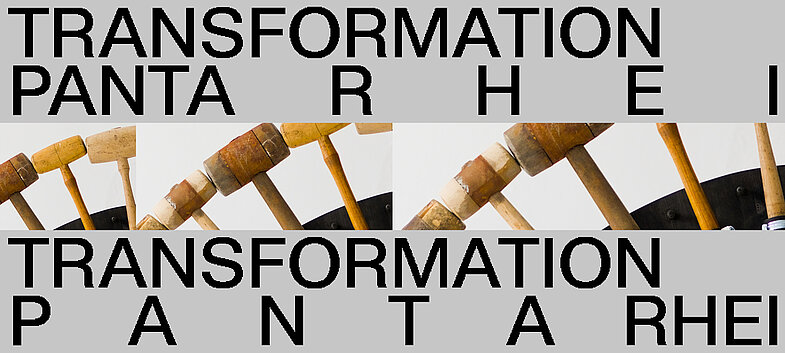
Universal flux. Everything is constantly developing, be it language, viruses or we humans and our needs. Everything seems to be a never-endingprocess of adjustment and improvement. For its part, the Künstlerhaus has also gone through different transformations. Built in 1924 as a wash house, today one can still spot its walled-up entrance to the Westphalia coal mine. Later on the building served as part of the college. And for 41 years now it has provided a home for art and artist’s workshops. Often this sort of conversion or misuse can also be found in art, whether rapid or slow alterations, disposed mobile phones or climate change. What shapes us humans during a lifetime and which diverse lives fill space and time. You can’t prevent change from happening.


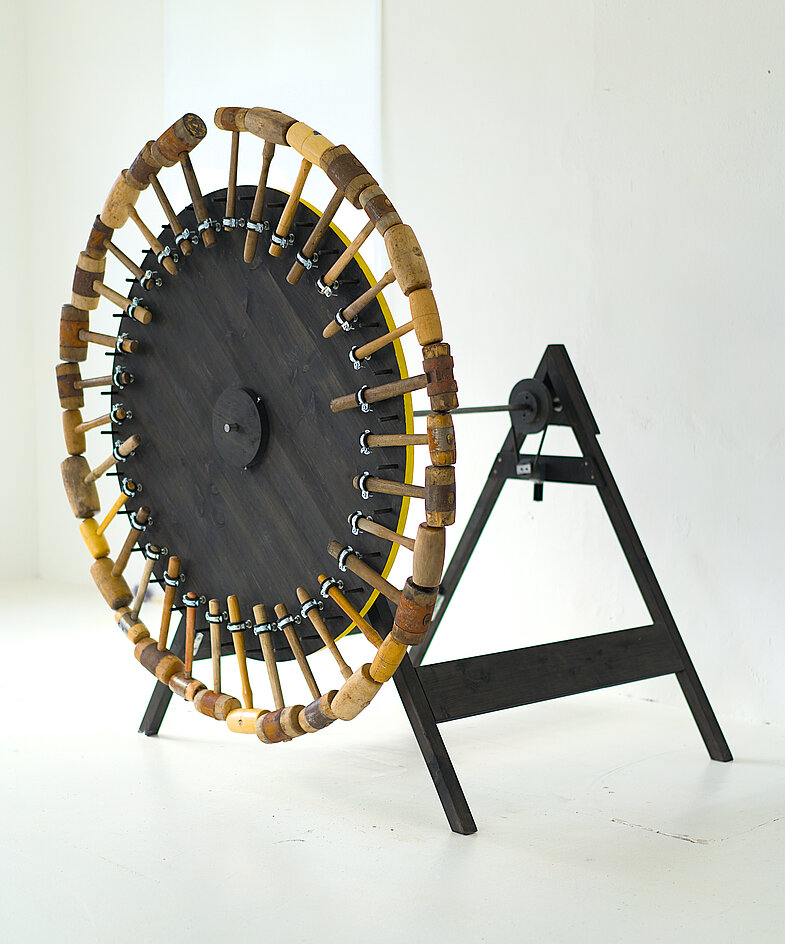
Wheel Series III is part of a larger series of works entitled The Wheel. The series centres on the wheel as a symbol of transformation, oscillating between the old and the new, the past, the present and the future. Historical developments are taken as a starting point to explore our cultural roots and use the insights gained to examine current technological progress and sustainability strategies. The ability of technologies to improve the quality of life is the focus of the works in the series. The Wheel Series III consists of a set of decommissioned wood hammers mounted on a wheel driven by a motorised belt system. The hammers come from a plumber's workshop that was founded in the early 20th century in St. Georgen in the Black Forest and has been in the family for four generations. The hammers, a central piece in the sculpture, as a manual tool was used for most of man's histories here are moved by a motor. The artist's intention is to depict a metaphor by automating the movement: The motor does not separate the work from human activity, but becomes a modified object that optimises human labour. Circular movement, repetition, cycles and loops are recurring elements in the formal language of Hernández's works.The wheel, too, is driven by a subtle rotational movement and is related to time and space. For the artist, the wheel is again a metaphor. However, unlike the hammers, it does not stand for optimised and automated work processes, but for change as well as for those cycles of past eras that are forgotten and rediscovered. For the artist, the wheel also refers to clocks, an instrument that marks time and space. The measurement of time is defined by the beating of the hammers, which is reminiscent of the collective rhythm of the former family business in St. Georgen.
is a Spanish artist living and working in the Black Forest in Germany. In 2008, she graduated with a MFA Fine Art from Goldsmiths, University of London, having received her BA in Fine Arts at the Polytechnic University of Valencia in 2002. Irene Pérez Hernández is a sculptor working across a wide range of media. Her works frequently explore the territory between sculpture, video and performance and seek to challenge historically-coded associations between materials and contexts. Rooted in an interest in the interaction of line, motion and space, she produces sculptures and installations that interrogate the quotidian rituals of domestic life inscribed in the fragile social and political landscape of late capitalism. Her performative works often involve repetitive acts or rhythmic presentations of visual images. Installations responding to, or encoding meanings in, specific spaces are also a key component of her expansive aesthetic project.
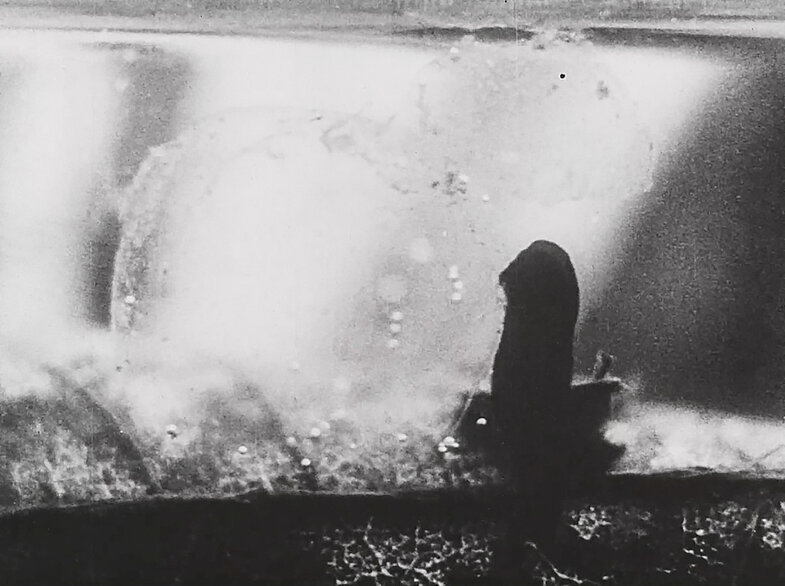
In May 2020, in the midst of the first big lockdown in Germany, I had the idea of conceiving an international arts project. A project that related to the idea of infection, but also based on the pun on Covid/Ovid, with the C in parentheses - (c) - so that it resembled the sign for copy(right) - with the larger idea to create ‚positive antibodies‘, so that art could attempt to become a healing force. I asked my sound artist friends Lasse-Marc Riek and Thomas Köner, if they would like to jump on board - Thomas was a great sparring partner in fine-tuning the final conception, and Lasse-Marc was an incredible comrade in actually organizing all this; we ended with 19 sequences (Covid 19), played by 133 international artists.
The international participants come from the arts: from literature, music, video art, sound art and photography. They are the actors, but it is their practice that gives shape to the forces and makes them tangible: the real agents are the transmission channels. The transmission paths, the infection paths between the hosts, the artists, are more than just a structure, and the mutations that run across them in the process are the real creators; the artists, once infected do „their thing“ - the metamorphoses happen in transmission, and our project makes them audible, visible, tangible. (c)ovid's metamorphoses creates series, it processes transformations in which what is said and meant is transformed through media, text into image, image into sound, sound into thought, thought into form, form into substance and back again. The transformations are substantial, as in Ovid’s Metamorphoses, in which mostly humans are transformed into a component of botanical, animal, mineral or astral nature.
Displaying works by (chronological):
Bill Morrison with Maja S K Ratkje, Sebastian Wiedemann with Michael Gordon, Hedvika Hlaváčková with Jacob Cooper, Raphael Kariuki, Austine Lordlaz, Claus Stoermer, Fotonik Noise (Ali Beidoun), Philipp Bückle, Kaveh Nabatian with Ashley Jane Richards, Ville Tanttu, Karel Doing with Karel Doing, Lawrence English with Xu Xin, Darius Ciuta with Julia Mihaly and Charlotte Hoechsmann, Achim Zepezauer, Vincent Moon with James Yorkston, Vincent Moon with Jonas Noack, Sebastian Scherer, Evangelos Papadopoulos with Eva Pöpplein, Ayman Zahle with KMRU_Scanner and Laima Jansone, Thomas Köner with Ayman Nahle, Anthony Joseph with Ayman Nahle.
Bernd Herzogenrath is professor of American literature and culture at Goethe University of Frankfurt am Main, Germany. He is the author of An Art of Desire: Reading Paul Auster; An American Body/Politic: A Deleuzian Approach and editor of a.o. The Farthest Place: The Music of John Luther Adams and Deleuze/Guattari & Ecology. His latest publications include the collections The Films of Bill Morrison. Aesthetics of the Archive (Amsterdam: Amsterdam University Press, 2017), and Practical Aestethics (London and New York: Bloomsbury, 2020). He is also (together with Patricia Pisters) the main editor of the media-philosophical book series thinking/media with Bloomsbury.
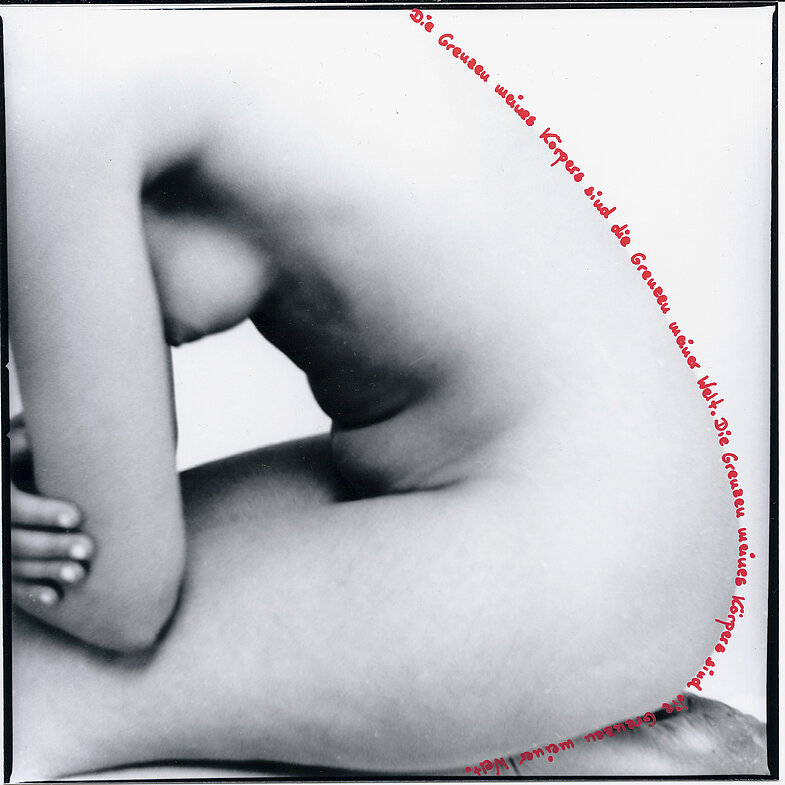
The exhibition shows analog black-and-white nudes of women in which selected parts of the body have been covered with text. The writings tell an interrelated story of pain and loss. A special filtering technique allows the disappearance of these fine lines written in red color, making the original unharmed female body reappear.
In the interdisciplinary project PHOTEXT, which is situated between literature and visual art, the photographer Anna Melnykova and the writer Vera Vorneweg want to explore what similarities there are between the medium of photography and the medium of writing and how these two media can complement each other in perspective. The two artists met in May 2022 in the artists' village of Schöppingen and would now like to deepen their collaboration in the context of a new artist residency.
Hanna Melnykova is a Ukrainian photographer, director and founder of the Ukrainian women photography organization. Hanna graduated from the Royal Academy of Arts in the Netherlands. She developed her own study program in the field of visual arts and taught at the Bird in Fligh school (Kiyv), Pinchuck art center (Kiyv), Karazin National University (Kharkiv), Kharkov Academy of Design and Arts (Kharkiv). In 2020, during the lockdown, she created the Ukrainian Women Photographers Organization. Last years Hanna was a curator of international exhibitions and residencies in Europe and USA. As an artist she is currently researching and working with experimental techniques in photography. Her photographs are in private collections in the Netherlands, Italy, Belgium. Her first book “Largo” dedicated to the study of gender in modern society was represented during the UNSEEN festival in Amsterdam. After the russian aggression in Ukraine Hanna moved to Germany where she is continue to develop her artistic practice.
Vera Vorneweg (*1985) lives as a writer and artist in Düsseldorf. After numerous publications in anthologies and magazines, her debut "Kein Wort zurück" was published in 2022 by Edition Muschelkalk at Wartburg-Verlag. Since 2020, Vera has been working with text in public spaces, describing alternative surfaces such as chairs, tables, stones, walls, containers. With these large-scale literary installations, she significantly shapes the field of visual prose. She has received several awards and grants, including "Künstler*innen im ländlichen Raum" (2018), Harald-Gerlach-Preis (2019), Künstlerstipendium NRW (2020), 1:1 Mentoring Program with Marion Poschmann (2022), Künstlerdorf Schöppingen (2022), and Literatur-Förderpreis der Stadt Düsseldorf (2022). Vera Vorneweg is the curator of "Kunstkiosk" - a Düsseldorf event series with readings and exhibitions of concrete poetry.
www.instagram.com/veravorneweg
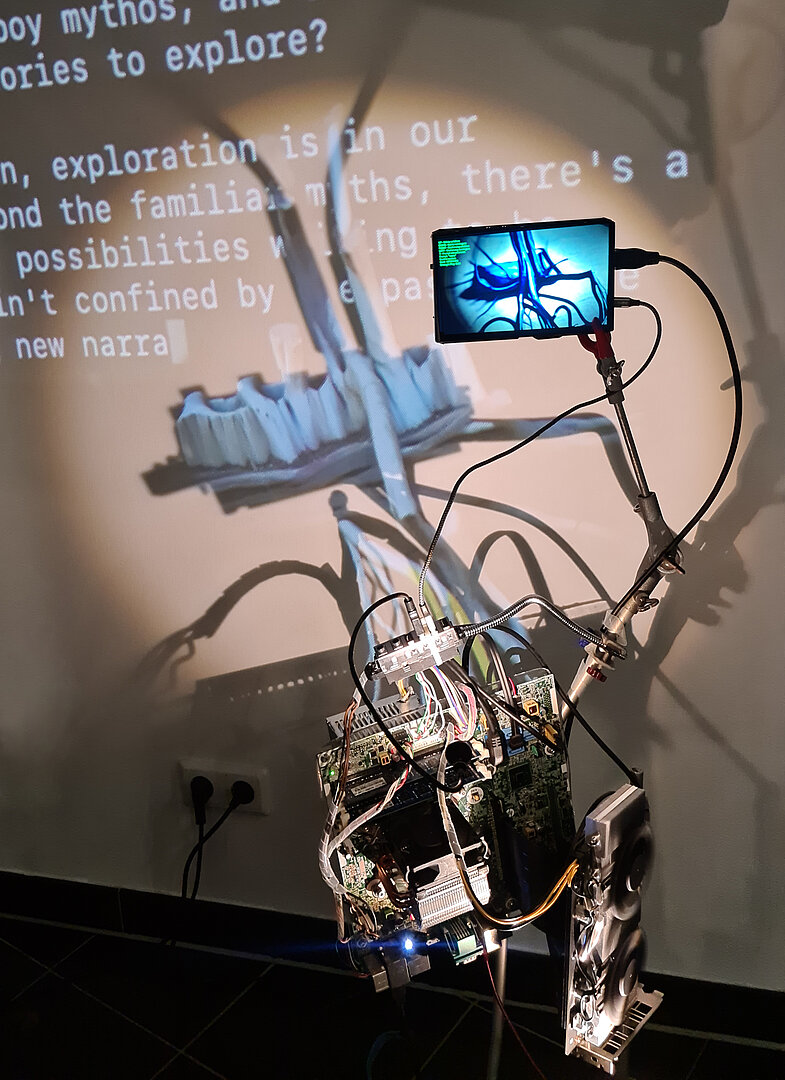
Former office computers, reformed and reformatted for forms of artificial intelligence, perform as backbone for transformative processes, forming new formations, form morphs from form to form, reform former forms forming new narrative nonconform forms.
RaumZeitPiraten (Tobias Daemgen, Jan Ehlen, Moritz Ellerich) are a space and time bending artists group at the intersection of art and technology. Since 2007 they are misusing and remixing ancient and up-to-date auditive and visual technologies for heterogeneous, organically improvised light and sound architectures. Their activities are aimed at playful, experimental connections of sound, image, object, space and time to an alternately-self-expanding-multimedia-performance-surround-spaceship-laboratory-travel to somewhere between science and fiction. They wander the globe with multidimensional environments, immersive light art, optoacoustic instruments, rhizomatic light sculptures and audiovisual performances.
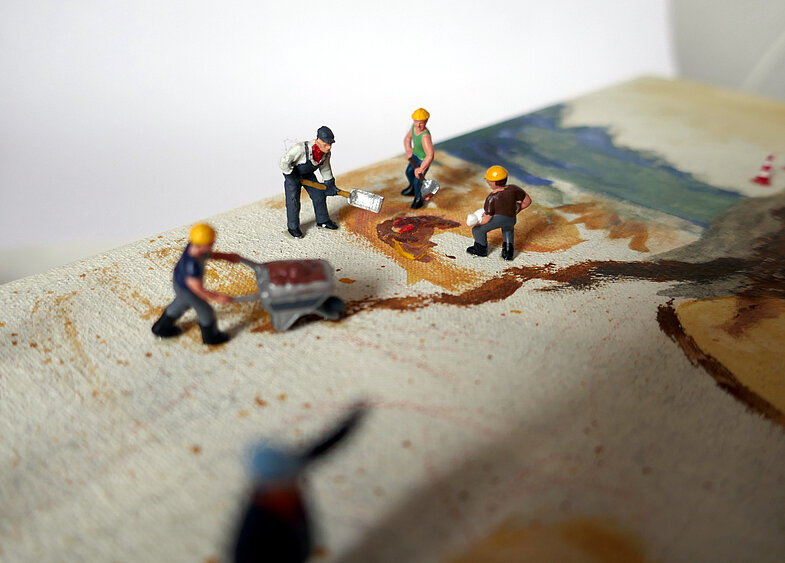
Mona Lisa in Arbeit plays with perspectives of artistic progress and raises the question, how “great” art actually comes into being. Is the genius throwing paint and light onto the canvas or are real craftsmen needed who carry out their tasks in a completely mundane manner in accordance with building regulations and collective agreements? In a world where everything can be delivered prefabricated for a fee, the appreciation for the actual manufacturing process, craftsmanship and dedication to the work is lost. This doesn't just apply to art, but extends to other areas, from technology to clothing to food. A change of perspective, coupled with humor, often helps to make this distortion conscious.
Tanja Roolfs is a master goldsmith, artist and musician and lives in Mainz and Norden. She is a member of the board of the Mainzer Kunstverein Walpodenstraße 21 e.V., the GedoK Mainz -Wiesbaden and the Chamber of Crafts. Since 1999 Perfomances, publication and music as horstundireneschmitt with the artist Brandstifter in Europe, USA and India, Curating, organizing and implementing exhibitions and events at the Walpodenakademie Mainz.
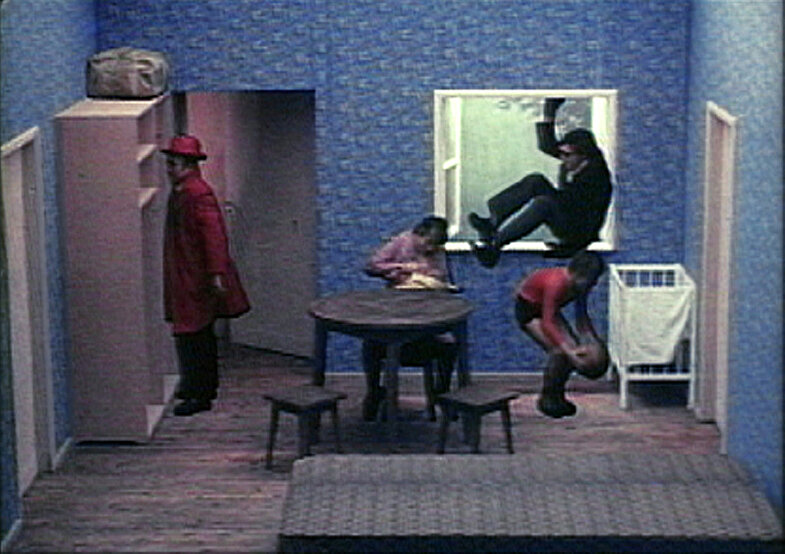
Academy Award-winning masterpiece is a surrealistic tangoof alienation of thirty-six people trapped in one room, representing the feeling of oppression, confusion, love, and tension. Ironically in 2020, it's like looking at your own life projected on the screen during lock-downs and quarantine. Tango is an Oscar-winning film shot on 35 mm film, created with an optical matting process. It is an experimental short film categorized by The Academy as an animation, because it is shot with stop-motion photography, therefore not the regular film speed rate. Especially in comparison with the kind of movies we see today in the Short Animated Film category, Tango is not a typical animation because actors are performing in real sets. Zbig is more an experimental filmmaker and special-effects inventor than a classic animator.
Zbig Rybczynski is a renowned filmmaker and HD pioneer, celebrated for his innovative contributions to film technology. Over his five-decade career, he has earned prestigious accolades, including an Oscar, Emmy, and three MTV awards, including Hall of Fame induction. Zbig's diverse portfolio includes creating music videos for artists like Mick Jagger, Yoko Ono, and Herb Alpert (just to name a few), along with groundbreaking HDTV films such as "Steps" and "The Orchestra." Zbig holds multiple US patents in film techniques, and he has played a pivotal role in pioneering real-time multi-layer image creation technology. As a respected academic, Zbig has taught at esteemed institutions around the world and holds two Honorary Doctorates for his significant contributions to the field.
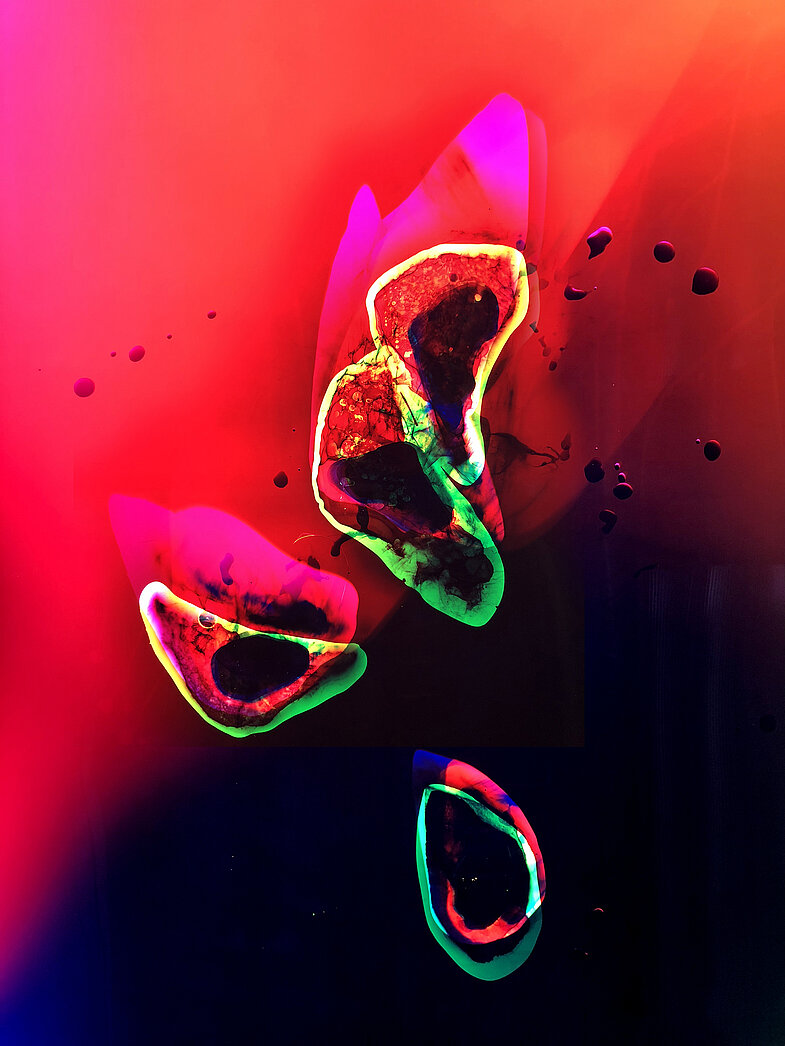
MELTING DIAMONDS is a continuous inventory whose purpose is to list the different types of ice, using photograms of glacier pieces. The photogram is a photographic process without a camera, invented in the 19th century. The result looks like an X-ray of the object: a precious diamond printed on the paper. The MELTING DIAMONDS series, Field Studies highlight the fragility of glaciers, and keeps in a unique print a last trace before the disappearance.
The Swiss legend of the “Armen Seelen" (poor souls) relates the souls of those who, during their lifetime disrespected nature, therefore imprisoned in glaciers after their death. The photos HEAD OF ROSES show the molded head of the artist in ice with enclosed plants. When the ice melts, all that remains of the sculpture is the vegetation. The ice reflects the ephemerality of life and its programmed disappearance to reveal flowers shows that when one thing disappears it gives way to another.
Anna Katharina Scheidegger was born in Switzerland (1976). She attended the ENSAD (Ecole Nationale Supérieur des Arts Décoratifs) in Paris and graduated with distinction in 2003. She continued her studies at Le Fresnoy, studio national des arts contemporains. Later, she became a member of the Académie de France à Madrid (Casa Vélazquez). She currently resides in both Paris and Bern. Anna Katharina Scheidegger works in a variety of media.
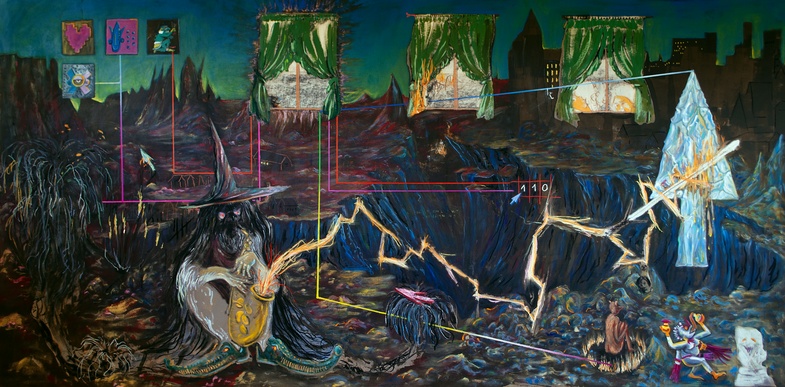
Yasin Wörheide's kaleidoscopic pluralism of methods brings to light works that reflect on the weighty heritage of European art modernism as well as contemporary realities of life and question the global world and value system. Charming, with the coolnes of a busker with cracked iPhone display. Wörheide's cross-genre approach leads to the creation of works in the fields of painting, sculpture, graphics, sound and new media. The starting point of his work are the three pillars; Reality, digitality and spirituality. Wörheide is primarily concerned with post-digital animism, transhumanist analogies and creation myths in the context of social space. A universal primordial substrate radiates forth from all these works, making their stories just as readable to contemporary viewers as they are to those hypothetical creatures who will dance in the ruins of this world long after them.
His works have been exhibited at the Northern Light Gallery in Kristiansund (Norway), the KIT in Düsseldorf and the Kunsthalle Münster as well as in various galleries in North Rhine-Westphalia. Wörheide is a cultural and freelance visual artist. He studied at the Kunstakademie Münster with Professor Michael van Ofen and was appointed his master student in 2017. Since 2020, Wörheide has been active as a scenographer in the independent theatre and music theatre scene. Among other things, he designed stage sets for productions of the Theater im Pumpenhaus in Münster as well as for the young collective Musiktheater Karlsruhe. This year he is collaborating with the international dance theatre Bodytalk, among others.
*please verify you’re not a robot - select all images with stoplights*
1 June - 7 July 2024
Opening
Friday, 31 May, 7 pm
Artists:
Irene Pérez Hernández
Bernd Herzogenraths (c)ovid's metamorphoses
Hanna Melnykova & Vera Vorneweg
RaumZeitPiraten
Tanja Roolfs
Zbig Rybczynski
Anna Katharina Scheidegger
Yasin Wörheide
Curator:
Ach Kuhzunft
Curator's tour
Friday, 31 May, 5.30 pm
Images works: © the artists
Title graphic: © Jonas Brüggemann & Viola Dessin
Images opening: © JS/Künstlerhaus Dortmund
Kindly supported by: Kulturbüro Dortmund
Cooperation partner: Ruhr Museum
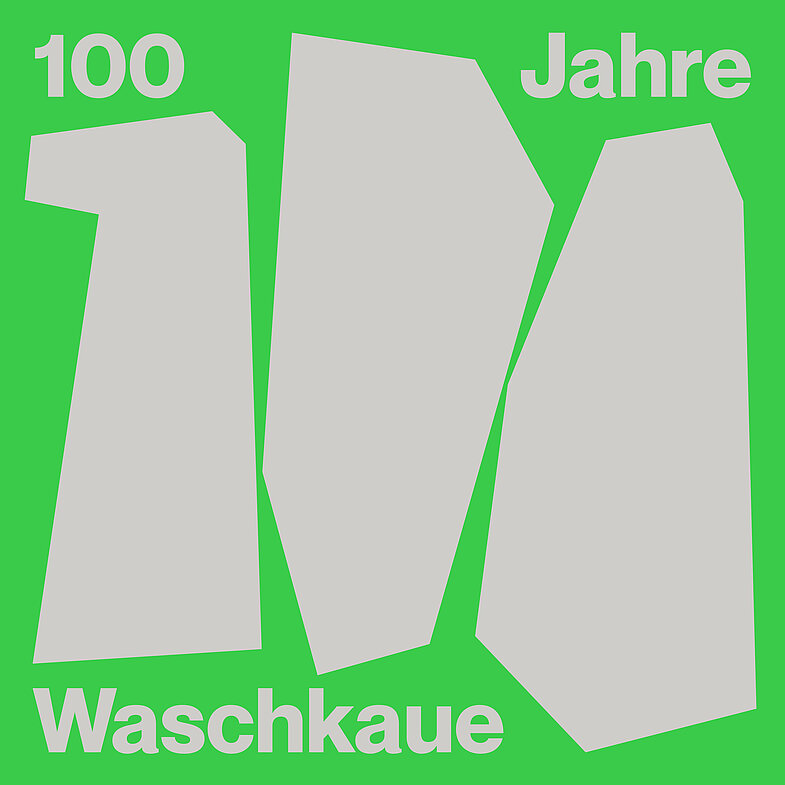
Transformation is the last of three anniversary exhibitions to mark the 100th anniversary of the Künstlerhaus Dortmund. The building was constructed in 1924 as a washhouse ("Waschkaue") and operations building for the Westphalia mine and was last used by the University of Applied Sciences and Arts for Design. Students from this school occupied the building and fought for its current status, self-administration. In 1987, the Künstlerhaus was renovated and converted with funds from the state of North Rhine-Westphalia, the city of Dortmund and Sparkasse Dortmund.
On June 14, at 6 pm, there will be an anniversary talk with Antje Hassinger (visual artist, founding member of the Künstlerhaus Dortmund), Dr. Ingo Wuttke (historian from the Ruhr Museum in Essen) and Norbert Grondorf (former miner).
In cooperation with the Ruhr Museum.